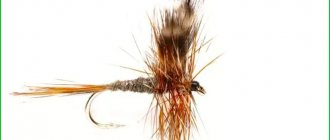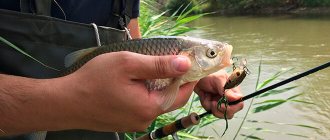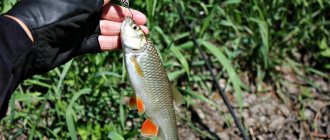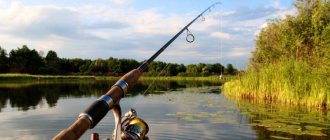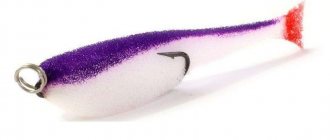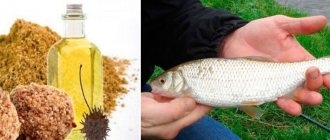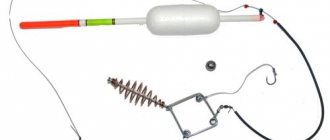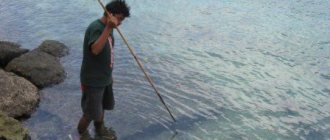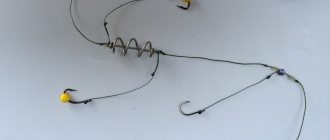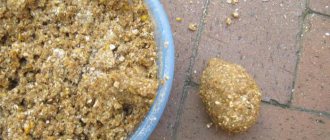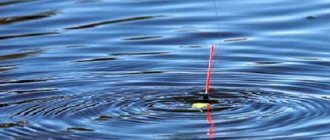There are fish along the border of aquatic vegetation, but most of them are in the grass itself. We can only hope that the loud slap of the “bug” on the water will provoke the fish to come out. The flat shores with aquatic vegetation are much shallower. In addition, many insects land on the stems of plants, which periodically fall into the water and become easy prey for fish. Unlike those fish that stand under a steep bank at the bottom and feed on seeds, these individuals cannot see what is happening on the surface. That's why they don't respond to surface baits.
For the fisherman, the question of choosing transport for traveling to the fishing spot remains relevant. For such purposes, transport must be convenient and passable. One option for going outdoors would be a scooter. Low gasoline consumption, the ability to drive in places inaccessible to a regular passenger car, fairly high speed, and the low cost of the scooter itself are just a few of the advantages of using a scooter for fishing.
All anglers have favorite baits that help out no matter what. I want to briefly talk about my favorite flies.
Fly beetle
"Bug". Without a doubt, this is the number 1 fly for chub. Another thing is what kind of “beetle”. After trying many options and sizes, I settled on two. In the spring (at the end of March and until the end of April) I use “bugs” on hooks No. 10-6. At this time of year, large chub are closer to the surface and are already actively feeding. In May, a lot of small chub appear and “bugs” on hooks No. 10-6 often become their prey. And you hope to catch a trophy! So I increase the size - I knit on hook No. 4. I also want to try on No. 2. Such a beetle cuts off small things - it cannot swallow it. And large fish are more willing to take large bait,
Wooly Bugger Front sight
Wooly Bugger. This fly is good for the period when the chub prefers to feed on fry. I knit it in white, black, olive, white with an orange tail. I make sure to load the front with lead and a brass head.
Front sight "Wasp"
Front sight "Wasp". It has proven itself well on rocky rifts, at the boundaries of stream and calm water. This fly looks very contrasting on the stream, and chubs (and often asps) do not remain indifferent.
Nymph "Mulberry". I gave this name to the nymph for its resemblance to a ripe mulberry. The front sight can be loaded with lead or left unloaded. Be sure to form a so-called “crown” near the head. This will allow you to correctly orient the fly in the water. I make the “crown” from partridge feathers.
Well, that’s basically all I know today about the preferences of the chub. When I manage to discover some more secrets in fly fishing for this fish, I will definitely share them with you.
Source: www.hunt-dogs.ru
Features of fly fishing for chub
Chub is often hunted due to the abundance of this type of fish; it is found in most reservoirs. In some of them it inhabits individual water areas, and in others it is distributed throughout the entire reservoir. No special skills are required to find the predator, since it often makes splashes while hunting for fry; usually it is possible to detect prey within the first 5-10 minutes of observation.
Chub fishing takes into account its preferences in choosing food, but it is very easy to guess the bait that the prey will like. The diet of fish is varied, it includes: fry, insects, small rodents, algae.
If you cast a fly into shallow water, you are highly likely to catch a small predator, and to catch large specimens you should fish for riffles, areas with steep banks, overhanging trees and holes. More often than not, fishing for large chubs is successful during the morning dawn.
Fly fishing for chub is one of the unique types of fishing
During daytime fishing, specimens of 200-700 g are often caught on a hook, and despite the small size of the fish, fishing in the daytime is the most exciting. The predator bites poorly in the current and practically does not take bait, but you can get good prey near the shore. The chub is just waiting for the time when the beetle falls from the tree. Fly fishing for chub from a boat is often more effective, since the fish shows greater caution and accuracy when a person appears, and from the water the predator does not expect a threat.
Catching a chub is not an easy task. To increase the likelihood of getting a good catch, we recommend adhering to the following rules:
- The more the fisherman swings the line, the further the tackle will fly. Experienced fishermen are able to cast weightless flies at a distance of 20 m;
- For chub it is better to take floating lines, since the fish hunts on the surface of the water. If the bait imitates fry, you can take models with a sinking end;
- It is important to create conditions during casting so that the bait first touches the water surface. A falling line can scare a fish;
- The best results are shown by flies that imitate natural food, that is, fry and various insects. At the end of April and beginning of May, the most successful bait is an imitation of the cockchafer; the rest of the time: dragonflies, beetle larvae, grasshoppers, caterpillars, etc.
Installation of equipment
Let's consider the process of installing sbirulino equipment. Nothing complicated:
- We put a locking ring on the main line.
- We pass the main line through the float. The float should be positioned with the widened part down.
- Next to the float we put on the second retaining ring.
- We tie a swivel to the end of the fishing line. More experienced fishermen tie on several swivels to further secure the leash.
- We tie a leash with a hook (fly or other bait) to the swivel.
Some fishermen use an installation scheme where the float is the final part of the equipment, and the leashes are located above the float along the main line.
The following video explains in detail all the components and the method of assembling equipment ready for fishing.
Fly fishing gear for chub
Many experienced anglers have their own peculiarities in assembling gear, but fly fishing gear for beginners is always made as standard. Classic tackle requires the use of fiberglass, carbon fiber and bamboo rods. A fishing rod from class 5 to 7 of hardness is suitable for chub; it performs well when hunting predators weighing over 100 g, without exceeding a weight of 3 kg. The length is chosen in the range of 2.5-3 m. When choosing a fishing rod, it is important to pay attention to its weight; it is optimal to take 100 g.
For fly fishing for chub, special gear is equipped
A fishing rod with a cork handle is much more convenient and lighter compared to plastic models. Regarding the action, everything is not so clear: during strong winds, a fast action shows itself better, but a slow action makes the casting more accurate.
It is important to know! Models with an agate insert in the ring at the top of the rod are a must for a durable rod. This element bears a large load, causing the ring to quickly wear out, and a special insert prevents a destructive effect on the rod.
In addition to the fishing rod, other parts of the tackle will be required:
- coil. A classic inertia with direct casting is suitable. If desired, the tackle can be equipped with a multiplier reel or an automatic model. A brake must be built in;
- cord. Selected according to the class of fishing rod. A cord with a diameter of up to 0.2 mm is used for the chub. Sold in different colors, the most popular is white, but it all depends on the body of water. Additionally, backing is used - this is an auxiliary cord, the task of which is to raise the level of the main cord closer to the edge of the drum. You can use fishing line as backing;
- leash. It is the connecting part between the cord and the nozzle. Mostly a long leash of 2-2.5 m is used, it depends on the fishing conditions. Many rigs use the division of the leash into 2 parts: short (50-80 cm) and long (1.5-2 m);
- front sight. Fly fishing involves using lightweight baits, so flies are the best baits.
Assembled tackle
The modern fishing world is rich in a wide variety of different gear. There are several possible options for fly fishing in this list:
- Fly fishing gear, which consists of a rod, reel and line. It is the oldest device for fly fishing. Fly fishing is a broad and constant creativity and experimentation of fishing with light bait that imitates an insect. The tackle is particularly delicate and requires a lot of experience and skill from the fisherman.
- Ship. This tackle is a wooden device to which a fishing line with leashes is attached. The fisherman is on the shore, and the boat floats downstream. Flies on leashes cover a large area when rafting. This tackle shows excellent results on asp, perch and chub.
- Spinning tackle with a bombard. A sbirulino or bombard float allows you to cast a spinning rod over a very long distance. To equip it, first put on a float, then a few swivels and finally a leash with a fly. Considering the positive buoyancy of the float, the bait does not sink, but is carried in the upper layer of the reservoir. This tackle is suitable for catching any type of fish listed above.
- Spinning tackle with barbs. This tackle is designed for catching perch. A sinker is attached to the end of the rig, which will stretch along the bottom. And above the load, leashes with flies are tied at equal distances.
- A tug is a tackle for catching chub, which consists of two spinning rods connected to each other by a fishing line. When fishing with this gear, anglers stand on different banks of the reservoir, and leashes with flies are tied at the level of the middle of the river. By twitching the spinning rods, the game is played with flies. Considering the fact that anglers are far from where the bait is playing, this tackle is great for catching the most wary fish species.
For fishing with flies, you can use several types of gear:
- A “water kite” or boat is a tackle consisting of a foam, wooden or any other floating body to which a fishing line called a “stave” with several leashes is tied. The main spinning line is attached to its other end. The “snake” is cast away from the shore with the expectation of its further movement with the current. This gear is used to catch schooling fish such as asp or grayling.
- “Peryatyaga” is a device consisting of two spinning rods located on different banks of the river. A “bet” with leashes is stretched between the spinning rods. To operate this gear you will need two people who will slowly move along the banks against the current. “Peretyaga” works well on rivers with moderate currents when fishing for chub and roach.
- Fly fishing is a classic tackle for fly fishing. It consists of a special fishing rod equipped with a long cord with a leash. Ideal for any conditions when fishing for chub, roach, grayling, asp, trout, salmon, etc.
- Spinning. Can be used both with a weighted float of the Sbirulino type, and with weighted types of flies.
Fly fishing consists of the following elements:
- rod with reel;
- coil;
- cord with backing, running and leash;
- bait (fly);
A special rod is used for fly fishing gear. Today on sale you can find fly fishing forms ranging from 2 to 6 meters in length. They can be one- or two-handed. The latter are used for fishing at considerable distances, and casting the tackle is done with both hands.
One-handed fishing rods are more popular due to their ease of use. Most often, blanks up to 3 m long are used. Fly fishing rods are made of ultra-light carbon fiber. The weight of the longest blank does not exceed 200 g. Like all fishing rods, they are divided according to action from very fast to slow.
The equipment is quite simple at first glance, but it must be put together correctly:
- To begin with, the main line is wound onto the spool of the reel to the level of comparison with the restrictive sides.
- Next, the end of the fishing line is passed through all the leading rings on the rod and brought out at a distance for conveniently equipping it with additional elements.
- The first rubber stopper is “put on” the fishing line, which will prevent the bombard from moving from the planned level.
- Next, the main line is passed through the ring on the float, followed by the second limiter.
- A swivel is tied to the end of the fishing line, and a leash with a hook or other fishing gear (for example, a spinner) is attached to it.
Choosing a place and time for fly fishing for chub
Experts begin hunting for chub after the ice melts; the tackle remains effective throughout the season, until the temperature drops sharply in the fall. The bite is observed all day, but is more active during dawn and dusk. At night and during the day during the heat, fish are difficult to hook, but at night trophy specimens are often caught.
Fly fishing for chub begins after the ice has melted and lasts until the onset of autumn cold weather.
It is better to go fishing in good and stable weather, since during bad weather the bite becomes rare or completely absent. Before going fishing, it is better to give the weather 2-3 days so that some stability occurs and the atmospheric pressure stops jumping. But a slight wind, creating ripples in the water, is useful to the fisherman; the bite only increases, because the fish are less careful, see the shore less well and at the same time remain active.
In the warm season, large chub live in riffles and areas with intense currents. After the water temperature drops, the predator tends to spend more time in the water column in a place with little current. Particularly active biting is observed in holes near the shore, over which there are overhanging bushes and trees - this is the main source of food for fish.
The chub loves areas:
- close to whirlpools;
- bordering two currents with different flow rates;
- steep banks, a predator waits for frogs (more common in autumn);
- exits from pits, boundaries of rifts (the best results are shown in the spring before the water warms up).
In spring, prey swims at a depth of 1-1.5 m, and as summer approaches it rises higher. The chub swims in the upper layer of water until cold weather sets in. The most catchy seasons are pre- and post-spawning zhor, as well as preparation for cold weather. During these periods, large individuals are often caught.
In September, baits that imitate fry perform better, as the fish gradually wean themselves off feeding on insects due to a decrease in their population. In October, the chub will not be on the rifts; it will gradually begin to approach the wintering pits. The prey does not stray far from the pits; casts should be made to the recesses, performing surface retrieval. When the temperature drops significantly, the bite will disappear completely.
Tandem
One of the most catchy tandems for chub is palmer and mosquito. To avoid overlaps, the palmer must be heavy.
For these purposes, use
- double No. 6 or 8;
- single hook No. 10 or 12 No.
The palmer is tied at the tip of the main line, and the mosquito, tied on a single hook, is attached higher on the other leash. It is preferable to make uniform wiring with a tandem.
Lures for fly fishing for chub
Today, dry and wet flies are often used, but small streamers are also used.
For fly fishing for chub, it is recommended to choose a fly that can go deeper into the water column
Flies for chub fly fishing
The chub often feasts on bugs and various insects that fall into the water. Flies imitate the predator's usual food, lulling its vigilance. Some extravagant options are also effective, but you will have to experiment for a long time to find a successful bait.
When choosing a dry fly, it is better to give preference to models that have an extremely invisible hook. Covered hooks are less likely to catch grass or branches, and the chub bites more actively on well-camouflaged models. The options that meet the described requirement are: Wooly worm, Wickham's Fancy, Ant.
Typically the fly is made from foam. One rule applies here - with a large fly there is a high probability of catching a large specimen, therefore, you should not put small baits. We recommend making a lot of turns of the pen, but not too much. If you feel that the hook is being pulled out of the prey’s mouth, it is better to reduce the number of revolutions.
The streamer is effective in catching large fish, because only in the second year of life the chub begins to chase fry, when it reaches a size of 20-30 cm. In shallow water, running along the bottom is often effective, but it is important to choose the right color of the bait taking into account the water. The main difficulty lies in selecting the correct weight of the bait so that it plays near the bottom. Wiring in small strips against the flow of water turns out to be successful.
Other attachments for fly fishing for chub
Fly fishermen often use the cockchafer as a bait; although the bait is seasonal, it is extremely effective. It is better to fish for beetles on rapids and rifts, taking a position at the top of the current and floating the bait down. It is better to fish without using a float, and the hook is threaded through the body of the cockchafer so that the point sticks out. It is better to do the hooks sharply, but at half strength, so as not to tear the bait out of your mouth.
In the second half of April and throughout May, the air temperature increases, and a beetle appears - the chub’s favorite dish
As summer approaches, the chub becomes a picky predator and will not attack any bait. It is important to frequently change baits in search of a more promising bait, one of which is the grasshopper. At night in warm weather it is good to catch moths; there are a large number of them in nettle thickets. You can also use flies, but you should plant 2-3 pieces at a time.
Tactics and fishing techniques
The chub bite occurs sharply, accompanied by strong tension on the fishing line. An inexperienced or relaxed fisherman may even have the rod pulled out of his hand. Often a bite is accompanied by a splash on the water surface, but the main way to determine a bite is the tension of the fishing line. If the prey has swallowed the bait, it begins to swim sharply to the side, now the fishing line is pulled, which is a signal for hooking.
Fishing is best done gradually at an average pace. If you pull the fish quickly, there will be an excessive load on the rod, and during the jerk there is a risk of the predator falling off. Fishing too slowly often leads to the tackle becoming entangled in silt, snags and other underwater obstacles. It is better to find the optimal pace by gradually reeling in the fish and letting it get tired. During the fishing process, the rod is held vertically. Large specimens are easier to remove from the water by moving the rod.
Correct casting and guiding of flies
On small rivers and streams, it is better to cast close to the shore, a maximum of 6 m. To cast, you will need a two-meter cord and undergrowth. The short length of the fishing line is due to the complexity of the swing due to adjacent bushes, trees, reeds, etc. It is advisable to cast according to the archer’s method - we take the front sight with the tip pointing upward, pull the cord and take aim through the curved ring. Then we release the front sight.
In small rivers, you must always control the fly, keeping the line taut, otherwise the tackle will get tangled, and when it is released, all the fish will swim away. You can use the rod tip or your other hand to retrieve the line. When casting over long distances, the selection should be carried out constantly, otherwise at the moment of hooking it will not be possible to achieve a sufficiently fast and sharp tension. It is better to recast immediately after removing the bait.
Originally posted 2018-07-20 13:24:49.
Source: rybalka.guru
Features of chub fishing
When planning to catch chub, it is worth taking into account the nature and behavioral characteristics of this fish. The chub mainly lives in rivers with active currents, the waters of which are saturated with oxygen. Most often it swims near the surface of the water. It descends to the bottom only from mid-autumn and lives there until the end of spring. A change in the behavior of fish and a change in the depth of habitat occurs at a temperature of 120C.
This type of fish prefers clay-rocky and hard sandy bottoms. It is almost impossible to find chub in places with a lot of silt. Most often, this fish can be found on bends and rifts of rivers, as well as near wooded banks. The fish can swim for a long time near bushes and trees hanging over the water, waiting for insects falling from the branches.
The chub is a rather shy fish. Having noticed a person on the shore, he will immediately go into the depths, ignoring any bait thrown at him. Therefore, you need to approach the shore carefully and maintain maximum silence. However, fish are often attracted to artificial structures in the form of dams, bridges and piled piers.
What does a chub look like?
Regardless of the time of year, chub can be caught using flies. However, in the summer, the bait must be light in order to float at the surface of the reservoir, and in the fall and spring it must be heavy, sinking almost to the bottom.
When fishing, it is important to choose the size of the hook and the number of weights. Hooks can be used under numbers 1 – 18. However, given the rather large size of the fish’s mouth, it is better to go with hooks No. 10. The number of weights depends on the speed of the current in the reservoir.
Lure nuances
You can catch chub using artificial flies at any time of the year. However, such baits are not the same and are classified according to the following principle:
- Dry flies for catching chub in the warm season. Such artificial baits are designed to imitate small insects caught in the water. For their manufacture, lightweight materials are used in the form of bird feathers, down of wild and domestic animals. After production, such baits externally resemble flies, dragonflies, butterflies, grasshoppers and other small insects. An essential element of such dry flies is fluffy plumage, which allows you to keep the bait on the surface of the water and ensures its natural movements.
- Wet or heavy baits are used to catch chub in cool water, near the bottom. Such flies are made from heavy materials in the form of dense threads, wool, pieces of leatherette and even metal wire. Externally, such flies for catching chub should resemble water beetles, caddis flies, tadpoles, as well as insect nymphs and pupae. Such baits are characterized by the presence of a minimum amount of plumage.
Dry flies are used only in combination with small hooks made of thin metal. Otherwise, a cunning chub can easily notice it. But to catch fish with wet baits, you must use exclusively thick hooks.
Advantages and disadvantages of artificial flies
Like any other type of bait, artificial flies have their advantages and disadvantages. The advantages of homemade or purchased simulator baits include:
- Product versatility. You can use flies to catch not only chub, but also grayling, ruff and many other fish;
- The small size and weight of the bait, thanks to which you can take several of them at once and compactly fold them into a small box or compartment of a hook organizer;
- Reliable fastening to the fishing line. The fly is initially made on a hook, so the chance of being left without bait during fishing is minimal;
- Availability of good bait for chub, regardless of the distance of the fishing trip;
- Long product life. One fly can be used effectively for several fishing trips;
- Availability of materials and low cost of bait when making it yourself.
Chub flies are quite durable.
The disadvantages of artificial flies for chub fishing are the following factors:
- In the event of a dead hook or a bite from a toothy predatory fish, in most cases the bait will be irretrievably damaged;
- The need for patience, imagination and the ability to handle threads and other materials for making flies yourself. Not every fisherman wants to tinker with small materials and parts.
However, the advantages of artificial bait are much greater than the disadvantages. After all, the use of flies instantly eliminates problems with the extraction and careful storage of live bait, which must also be transported to the fishing site in a fresh state.
Instructions for making your own fly
Making your own flies for fishing is a painstaking, but not too difficult task. Having made the bait once, the fisherman already clearly understands the principle of its manufacture, and can already come up with his own options for creating a realistic fly from other materials.
The easiest option for making it yourself is a dry fly. If you have all the necessary materials, its production can take just a few minutes.
Tools and materials
To make a fly for catching chub with your own hands, it is important to prepare all the necessary materials and tools in advance. So to make bait you will need:
- Vise;
- Fishing hook;
- Strong black threads;
- A bead with a hole passing through the hook;
- Bird feather;
- Animal down or decorative rooster feather;
- Mohair, if possible with the addition of metallic threads;
- Nail scissors;
- Glue.
To make a fly for chub you will need a hook.
But even after preparing all the necessary materials, before making a fly for catching chub, you need to think about the appearance of the future product.
Manufacturing
Making a fly for effective chub fishing is done in this way:
- A hook of suitable size is fixed in a vice, onto which a small bead is placed. The bead will imitate the head of an insect.
- The backing is made using black thread. The thread is wrapped tightly around the hook from the bead to the bend of the shank.
- Take a piece of bird feather and apply it to the backing. Using the same thread, but in the opposite direction, the feather is wound to the hook up to the bead. In this case, the beards must be divided into 4 parts. Excess feathers are carefully cut off.
- The body of the fly is formed from metallic mohair thread. The resulting fluffy ribbon is used to make turns on the hook in one or two layers.
- The fluff or feather of a decorative rooster is applied to the blank. The barbs are pulled back slightly from the top of the fly and the front is threaded onto the hook.
- After such fixation, the feather or fluff is carefully, together with the thread, wrapped around the hook in 2-3 turns. The winding of the thread is done near the head of the fly.
At the end of the work on making a fishing fly, the excess parts of the feather are carefully trimmed, and the thread is treated with glue to prevent it from unwinding while using the bait.
Casting and retrieving flies
To successfully catch chub, in addition to choosing the right bait, it is also important to cast it carefully and accurately. So, when fishing on small rivers and streams, casts are made at close distances. The longest casting range does not exceed a distance of 6 meters from the shore. To complete this task you will need:
- Cord 2 meters long;
- Undergrowth.
Casting bait is performed exclusively using the archer method. This will not only allow you to throw the bait into the water in the most natural way, but will also protect the fisherman from damaging the gear on bushes and trees with a normal swing.
To cast, you need to pick up the fly so that the tip of the hook is directed upward. After this, you need to tighten the cord and aim at the intended fishing spot with the curved part of the rod. Having taken aim, the fisherman must quickly release the fly. When there is a strong current on the river, the rod tip must be held strictly in the direction of water movement.
Wiring is performed by light rhythmic twitching of the cord. In the case when there is no bite, recasting must be done almost immediately, since the chub usually attacks the bait that the chub is interested in almost immediately after it hits the water.
You need to pull out a chub caught on a fly by slowly pulling it towards the shore. Since this fish fights hard and resists at the beginning of catching, it is impossible to lift the catch high above the water. When the chub gets tired of resisting, it can be brought underwater as close to the shore as possible and pulled out with a landing net or by the gills. The hook that the chub has swallowed deep into the throat is not pulled out on the spot, but cut off. It is for such cases that the fisherman should have several flies with him at once.
How to catch a chub with a bombard fly in the summer
The chub, like all representatives of the carp family, is a strong, persistent fish that does not give up until the last. It feeds mainly on live food - insects, grasshoppers, worms, frogs, and juvenile fish. The large chub is very voracious. But at the same time, like all cyprinids, he is very careful and timid. The bait should be presented more naturally. Fly fishing tackle meets this requirement to the greatest extent. However, in the presence of bushes and overhanging trees, this is very problematic. For such conditions, there is gear that is a kind of mixture of a fly fishing rod, a spinning rod and a float rod. This is sbirulino or bombarda.
This tackle was invented and named in Italy for trout fishing. However, you shouldn’t give all the credit to the Italians. Many experienced fishermen used similar gear back in Soviet times, where special floats filled with water were sold. This tackle has been successfully used for catching other types of fish, including chub.
It is for the chub that the tackle in question is most suitable, since it likes to stay on the flow of small rivers above overhanging trees. An elongated spinning rod with a soft action is used as a fishing rod for casting light baits, larvae, and beetles. To cast equipment over a long distance, use a special heavy float.
Features of fly fishing
Fly fishing for chub with a fly can be carried out as soon as the ice has disappeared from the water, and until late autumn. Fishing can be done around the clock. However, fish are most active at dawn and dusk. Weather also plays a huge role in fly fishing. The most suitable conditions for fishing are stable atmospheric pressure, light ripples in the water and light wind.
The main condition for successful fly fishing for chub is a soft landing of the fly on the water, which must occur before the line falls there. Otherwise, the fish will get scared and leave.
